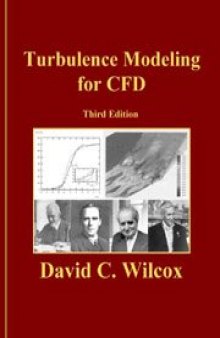دانلود کتاب Turbulence Modeling for CFD (Third Edition)
by David C. Wilcox|
|
عنوان فارسی: مدلسازی جریان توربولانس برای CFD (ویرایش سوم ) |
 دانلود کتاب
دانلود کتاب
 جزییات کتاب
جزییات کتاب
برای توضیح یک پدیده فیزیکی و درنهایت پیشبینی آن دو روش وجود دارد:
روش تجربی و آزمایشگاهی
روش تئوری
از آنجاکه استفاده از روشهای تجربی و بررسی آزمایشگاهی پدیدهها، زمانبربوده و در عین حال بسیار پرهزینه است، سعی بر آن است که پیشبینی یک پدیده بر اساس مدلسازی و شبیهسازی آن صورت گیرد.
دینامیک سیالات محاسباتی (CFD) یکی از شاخه های مکانیک سیالات است که مسائل سیالاتی را با استفاده از آنالیز عددی و الگوریتمهای عددی تجزیه و تحلیل می کند. به عبارتی دیگر CFD عبارتست از تحليل سيستمهاي شامل جريان سيال، انتقال حرارت و پديده های همراه با واكنشهای شيميايی بر اساس شبيهسازي كامپيوتری.
از جمله مزایای CFD میتوان به موارد زیر اشاره نمود:
كاهش زمان و هزینه طراحی فرایندهای جديد
توانايي مطالعه سيستمهایی كه انجام آزمايش روي آنها مشكل و يا غير ممكن باشد (نظيرسيستمهای خيلی بزرگ)
توانايي مطالعع سيستمها تحت شرايط تصادفي و بالاتر از حدود معمول آنها
سطح جزئيات نتايج بسيار زياد مي باشد
امروزه با توجه به پیشرفت و توسعه تجهیزات سخت افزاری و نرم افزاری، بهره وری از سیستم های محاسباتی بسیار مقرون به صرفه تر از روش سعی و خطا می باشد. یکی از روش های پیش بینی رفتار سیستم، روش های محاسبات سیالات می باشد. در این راستا، گروه صنعتی لوتوس با در اختیار داشتن نیروی کارآمد در زمینه شبیه سازی CFD، قادر به شبیه سازی پیچیده ترین مسائل می باشد.








 این کتاب رو مطالعه کردید؟ نظر شما چیست؟
این کتاب رو مطالعه کردید؟ نظر شما چیست؟
